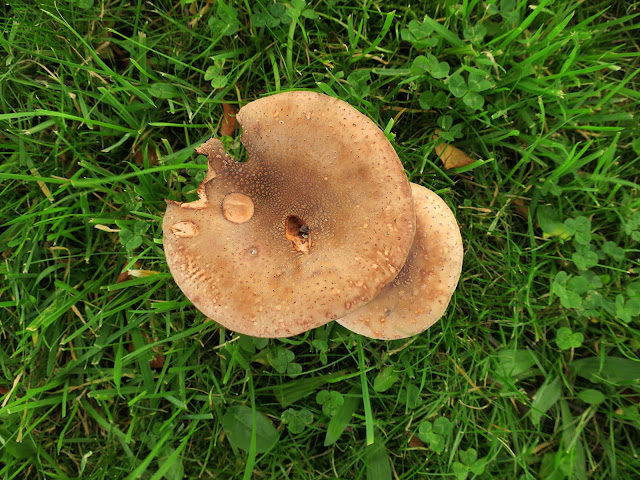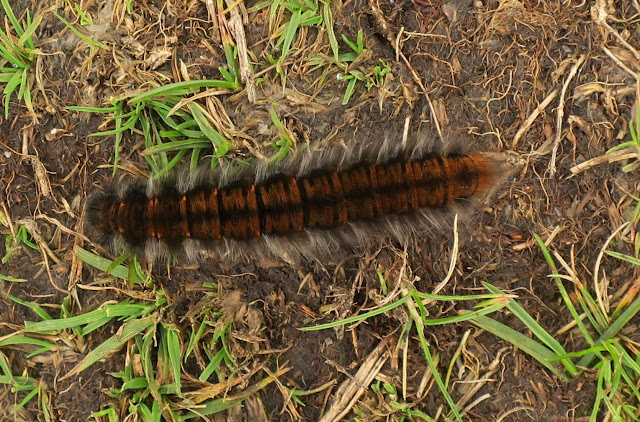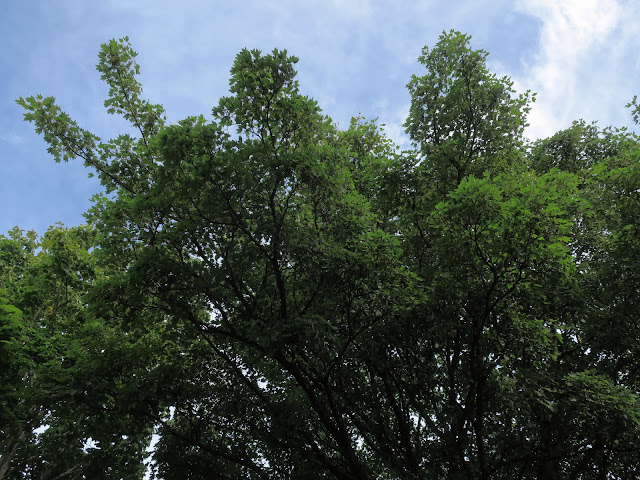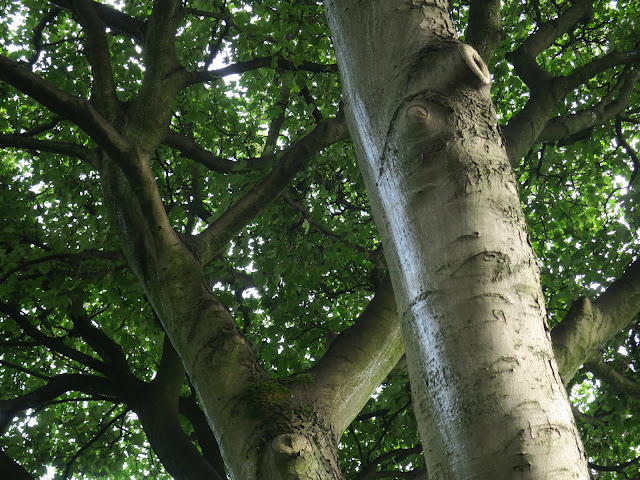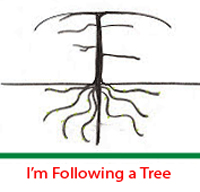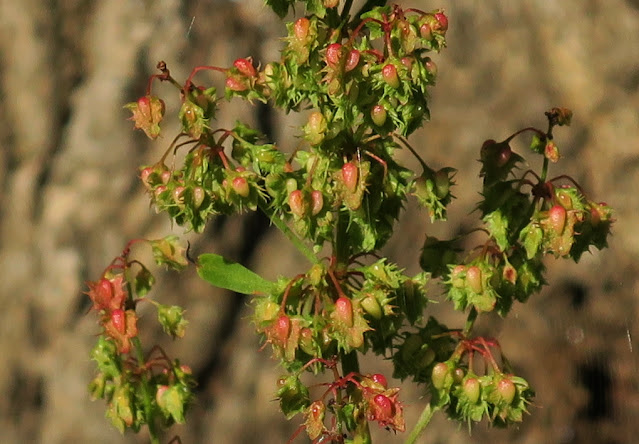It wasn't very many years ago that I first came across a ladybird larva - that particular one was a purple and black spiky little monster on a honeysuckle bush. And now I have come across ladybird pupa for the first time - funny little bright blotchy lumps stuck to flower pots and rubbish bins. And I've become more aware of where ladybirds are - surprising places like snuggling in lumps of sheep's wool on barbed wire fences. Here is a selection of observations from the last few months.
First is a seven spot ladybird (27th June 2020) on a dying plant in town. I wonder what it is doing there. I've peered into the photo looking to see if there are aphids for it to eat. No. I worry about it retrospectively. Why was the plant dying? Had someone poisoned it? Would the ladybird die too? What is it about ladybirds that we can't help feeling drawn towards them? Concerned for them. I really like coming across hover flies but I'm never tempted to invest them with personalities in the way I am with ladybirds.
 |
27th June 2020
|
Here's another (on the 8th August 2020) on the food waste bin outside my house - a harlequin I think. The council provides us with several different kinds of containers to throw things away in and each is a place to find ladybirds . . . and ants! If you zoom in you will see it has a thread attached. These threads are everywhere. I don't know what they are.
 |
8th August 2020
|
The next day I came across a strange cluster of at least three seven spots (I think) settled together in a bundle of sheep's wool. It's a warm sunny day. Why are they there?
 |
9th August 2020
|
I'll zoom in for you on this one.
On 28th August I come across a ladybird pupa (harlequin?) fixed to the outside of a steamed up car window. I think the white feathery bits are where it is attached. This attachment is quite firm. I had to remove another from a plant pot so I could wash it up and it was quite an effort. It may well have been a mistake to move it. Apparently they can flip up on these 'hinges' to avoid parasites. Trying to learn things from the internet leaves one very patchy. The inside of one of these bright little lumps is more or less liquid as it is formed into the more familiar beetle. How can it know when to flip up? How can it 'know' anything? I'm hoping some expert will tell me in the comments so I can change this text from bewildered wonder into proper information!
 |
28th August 2020
|
I'm going in date order through the year. It's not till the 31st August 2020 that I photograph a harlequin larva - the kind of creature that has turned into the pupa with the soup inside. Like the ladybird in the second picture it has a mysterious thread attached. It's on the big wheelie bin (with the ants). Do click on the picture to enlarge it. It is a most extraordinary creature.
 |
31st August 2020
|
And on 2nd September 2020 - another (harlequin?) pupa in the hinge of the wheelie bin lid.
 |
2nd September 2020
|
The pupa stage lasts only three to twelve days. How can the miracle of changing from a little spiky monster into soup and then into a ladybird happen in such a short time? If I were a real scientist I would probably start breaking them open to see what is happening but I am not. And they are real creatures.
Something else puzzling me. Earlier in the year there were thousands, possibly millions of aphids, in the sycamore trees. I'm not coming across them now. What do ladybirds eat in the autumn?
Last year I read a book about octopusses, squid and cuttlefishes. (
Other Minds - The Octopus and the Evolution of Intelligence by Peter Godfrey-Smith.) It was very disconcerting. On the cover there's a quote from a review in
The Times newspaper. "Fascinating and often delightful". Fascinating. Yes. Delightful? No. Horrifying. So many of the fascinating facts seem to have been discovered through interference in their lives. Why do we want to know about creatures to the extent that we will mutilate, torture and keep them captive? One octopus, kept in a tank, would damage equipment and squirt people. Good on him / her! I say. (I'm getting cross.) (Read it and see.)
Incidentally, I'm getting cross too about the push to build electric cars. To make enough batteries we, we humans that is, will need to dredge the sea floor for cobolt. So . . . we've worked our way through fossil fuels which have taken millennia to create, harmed the atmosphere as we've burned them up, and now we're moving on to something else to dig, scrape, desecrate. Meanwhile, I enjoy using my laptop which is made from metal and plastic. And I drink tea (transported across the world) from a mug made from clay (dug from the earth and which, when it breaks, will be finished with). And I am glad I was born in this century - because the horrors of the industrial revolution are over and I can reap its benefits without having to labour in a mine or a pre-unionised factory. Oh, it is so difficult to be moral!
I would like to visit other countries. I'd love to see the world. And maybe one day I will. I'm fascinated to know how other creatures function too - octopuses and ladybirds alike. But we have to curb some of our desires to push forward. (How do we know which ones? To what extent?) Some of you have been kind enough to say that reading my blog brings you hope and peacefulness. We need that. You also enjoy looking at the little things you find here; things you might otherwise pass by. May I encourage you too to look at the little things around you. Try looking in the hinges of your rubbish bins . . . in fragments of waste caught on fences and walls . . . these ignominious places. Because there are wonders there to rival the octopuses. Miracles of little monsters which turn into soup then re-form into spotty beetles. (What are all those spikes and colours for?) (Unanswerable question!) I have not been outside the UK in nearly ten years. And before that . . . it was about twenty years. Those visits were important. In England there's a lot of hardening; a lot of narrowness. We, as a nation, seem to be getting frightened of everything that isn't 'us'. And we are being more and more tempted into a slim idea of what 'us' means. If we travelled more, maybe we wouldn't be so frightened of what's 'beyond'. So there's the tension. Can we travel enough that we can learn to love our neighbours but little enough that we don't destroy the world? Can we be curious about our fellow creatures without feeling compelled to harm them? Can we be happy to stay at home? Can we be content to look without 'knowing'?
We need to know lots.
We don't need to know everything.
Ladybirds on the RHS site.
Links UK - more than 40 kinds
Links USA - around 140 kinds







